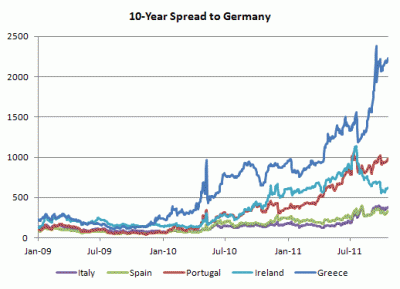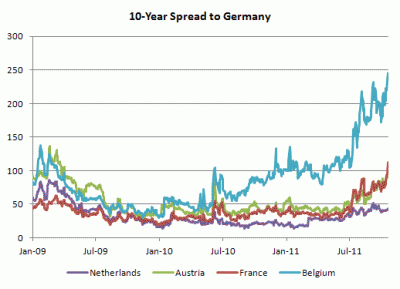France Back In The Spotlight
By Win Thin
Euro zone stresses are back in the spotlight with a report on France that was issued by Moody’s late in the North American afternoon. It was not a rating action but rather an annual update on the state of the country. The agency noted that France’s financial strength has weakened from the impact of the financial crisis, and that its debt metrics are “now among the weakest of France’s Aaa peers.” While Moody’s said that France’s financial strength remains “very high”, it notes serious challenges in the coming months due to the likely the need to provide additional support to other euro zone sovereigns (EFSF contributions) or to its own banking system. The punch line is that “The deterioration in debt metrics and the potential for further contingent liabilities to emerge are exerting pressure on the stable outlook of the government’s Aaa debt rating.” Moody’s added that it will monitor and assess the stable outlook over the next three months.
While the contents of the report should not come as any surprise, we do note that 10-year French and Belgian spreads to Germany have moved to record euro-era highs today. We have always viewed France as the most problematic of the so-called core euro zone countries. Indeed, our sovereign ratings model has shown France slipping into AA+/Aa1/AA+ territory since mid-2010, where it has since remained. The ratings agencies are finally coming around to our view, and we note that any sort of spike in government liabilities as highlighted by Moody’s would likely push France down even further into AA/Aa2/AA territory in our model. By most metrics, France is a weaker credit than the US, and so we think all the agencies will have to reassess its AAA/Aaa/AAA rating. The recent move by Moody’s to downgrade some French banks due to heavy exposure to Greece was viewed by us as a warning shot that would be followed up with sovereign pressures in the future. Moody’s report this week confirms this.
With France under the microscope, we think market attention will swing back to other core DM countries that are facing downward pressure on ratings too. Here is a summary of our most recent ratings outlooks for DM:
We note that the French developments underscore the fact that the supply of true AAA credits is dwindling. In Europe, there is still Germany, but we believe that as it takes on more and more countries to backstop, Germany’s debt ratios and fundamentals will deteriorate too. Now, it is a solid AAA credit, but the future is very uncertain. The dollar bloc, the Scandinavian countries, and Switzerland are left as very solid AAA countries, along with the Netherlands and Luxembourg. But taken together, these countries are a very small slice of global GDP and so investors have few options with regards to AAA safe havens.
Our model has the US as a weak AAA/Aaa/AAA credit, so we did not think that the downgrade was entirely justified on fundamental grounds. Our model gives the US score a small boost due to the dollar’s standing as the world’s reserve currency. Taking that out drops the US down to AA+/Aa1/AA+, but at this juncture, we see no end to the dollar’s premiere status. Over the summer, analysts were predicting all sorts of Armageddon scenarios if the US were to lose its AAA status. Well, it happened and the world is still here. In fact, US borrowing costs are lower now than before the S&P downgrade. So perhaps France and Germany should not be so worried about losing AAA status. It may be a blow to the ego, but life goes on. AA may be the new AAA.
After France, the next weakest euro zone credit is Belgium. Our model has Belgium at AA/Aa2/AA, below actual ratings of AA+/Aa1/AA+. Being without a government for over a year surely qualifies Belgium for a downgrade, since S&P took pains to note that the broken political process in the US was a factor in its downgrade. Moody’s put its Aa1 rating on review for downgrade earlier this month, citing the deteriorating financing environment for euro zone sovereigns as well as increasing risks to growth. The other two have negative outlooks, and so we think downgrades are likely and warranted.
Next comes the UK, which we have long viewed as a likely candidate for downgrades since our model has it as AA/Aa2/AA vs. actual ratings of AAA/Aaa/AAA. S&P had the UK on credit watch negative during the financial crisis, but took it off in 2010 after the incoming Tory government instituted fiscal tightening. With growth prospects dimming, we think the agencies will take another look at the UK’s AAA standing and start to consider downgrades. For now, all three have the UK on stable outlook so the first shots across the bow should be moves to negative outlooks in the coming months.
Moody’s cut Japan to Aa3 back in August after putting it on review in May, but put it back on stable outlook. We agreed with that move, and view Japan as AA-/Aa3/AA- compared to actual ratings of AA-/Aa3/AA. Only Fitch looks out of line now. Reconstruction spending may end up putting downward pressure on its ratings, however, and both S&P and Fitch have negative outlooks on Japan.
A word about the euro zone periphery is in order. We continue to believe that Spain, Italy, Ireland, and Portugal are all still facing significant downgrade risk. Only Greece at CC/Ca/CCC is close to correctly rated. And with euro zone growth slowing, these peripheral countries are likely to be downgraded further. Details below:
Our ratings model has Spain at A-/A3/A- vs. actual ratings of AA-/Aa2/AA-. Fitch was the most recent to cut Spain just this month. On July 29 2011, Moody’s put Spain’s Aa2 on review for possible downgrade. The three month review period is not hard and fast, since a similar review of Italy resulted in a multi-notch downgrade after almost four months. Still, we fully expect Moody’s to downgrade Spain in the next month or so, possibly multi-notch like it did with Italy recently. S&P cut Spain by one notch to AA from AA+ back in April 2010, and is long overdue for a downgrade after it moved Spain’s outlook to negative back in March 2011. All three agencies have a negative outlook, so further downgrades appear likely and warranted.
Our ratings model has Italy at A-/A3/A- vs. actual ratings of A/A2/A+. Italy showed remarkable stability in its credit standing during the early part of the crisis and stayed at an implied A+/A1/A+ for quite some time but finally succumbed in recent quarters to move lower. All three agencies have cut Italy recently and all three have kept negative outlooks, so further downgrades appear likely and warranted.
Our model has Ireland’s implied rating at BB/Ba2/BB, which suggests that actual ratings of BBB+/Ba1/BBB+ remain vulnerable to downgrade risk. We note that S&P and Fitch have moved their outlooks to stable from negative. This is interesting as well as unwarranted, as S&P and Fitch are the most out of line with our model and are in need of adjustment downwards. Moody’s has maintained a negative outlook on Ireland’s Ba1 while being the closest to our implied Ba2 rating.
Fitch recently said that it retained its negative outlook on Portugal’s BBB- rating, suggesting that a junk rating is still in the cards. Our model has Portugal’s implied rating at BB-/Ba3/BB-. Earlier this year, S&P affirmed its BBB- rating but kept a negative outlook. In July, Moody’s cut Portugal to a junk level Ba2 with a negative outlook. With all three agencies keeping a negative outlook, further downgrades to actual ratings of BBB-/Ba2/BBB- appear likely and warranted.
To complete our tour of the periphery, note that our model gives Greece implied ratings of CCC-/Caa3/CCC vs. actual CC/Ca/CCC. Those ratings are still vulnerable to downward pressure as S&P has a negative outlook, Moody’s has a developing outlook (which apparently depends on how Greek debt is restructured), and Fitch is at stable.



Comments are closed.